This post contains affiliate links.
Hummingbirds are magnificent creatures and are especially intriguing when seen up close and in person. I have watched many videos online and have been fascinated and amazed at how hummingbirds are fearless when it comes to finding food. I wanted to be a part of the action and fun so I decided to learn the most successful way to get a hummingbird to drink out of my hand.
How do you get a hummingbird to drink out of your hand?
- Make your training area attractive and enticing
- Purchase a closed-top handheld hummingbird feeder along with regular-sized feeders.
- Make your own homemade nectar.
- Spend 20 minutes a day using your handheld feeder.
- Remove all of your full-sized feeders and continue to use your handheld hummingbird feeder.
- Acquire their trust and be patient.
Luckily, it doesn’t take a rocket scientist to learn how to be successful in conquering this rewarding activity. It’s easy and fun and only requires continued participation. All you need to get started are hummingbird feeders, some patience and a few minutes regularly every day devoted to your training session.
How do I make my training area attractive to hummingbirds?
- Plant a variety of long tubular orange to red attractive flowering plants.
- Prepare your own homemade hummingbird nectar and fill in red hummingbird feeder bases.
- Maintain clean hummingbird feeders.
- Add a water element or display to your training area.
- Remove home pets or possible predators.
The provided combination of flowers and feeders to your training area will supply quick energy for hummingbirds. Water elements contribute to their mental health in a positive way along with their bathing rituals, an activity they love to participate in and entertaining to watch.
Creating the perfect backyard oasis will entice all of our potential friends to visit and stay.
Attractive Hummingbird Plants
In your backyard training area, plant a variety of orange to red long tubular flowering plants. This flower shape is known to hold the most nectar.
Popular plants that attract hummingbirds are any type of Salvia, particularly the “Hot Lips”, and the Cigar Plant. Both plants are drought tolerant and bloom most of the year.
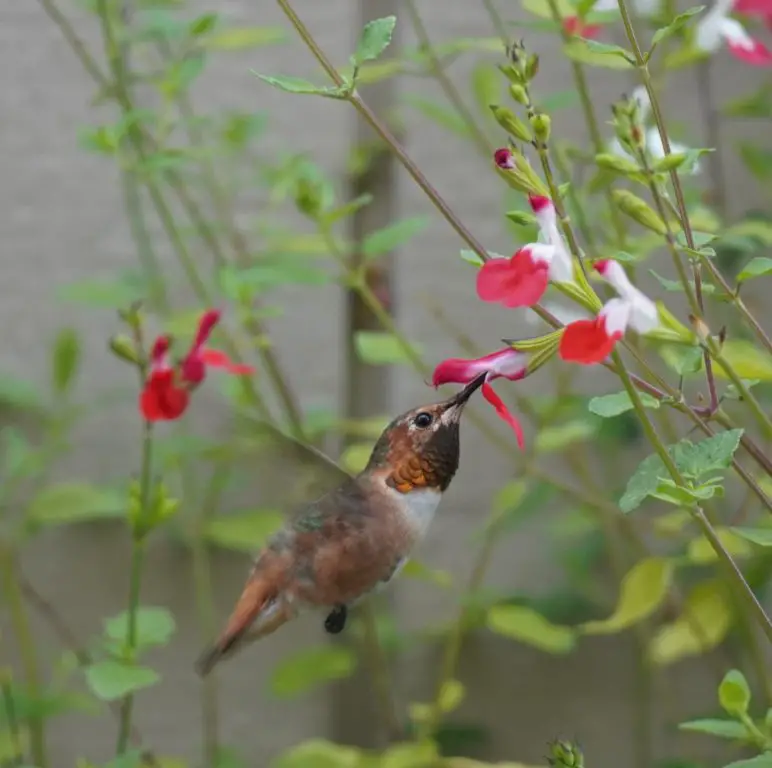
Male adult Allen’s hummingbird – (Selasphorus sasin)
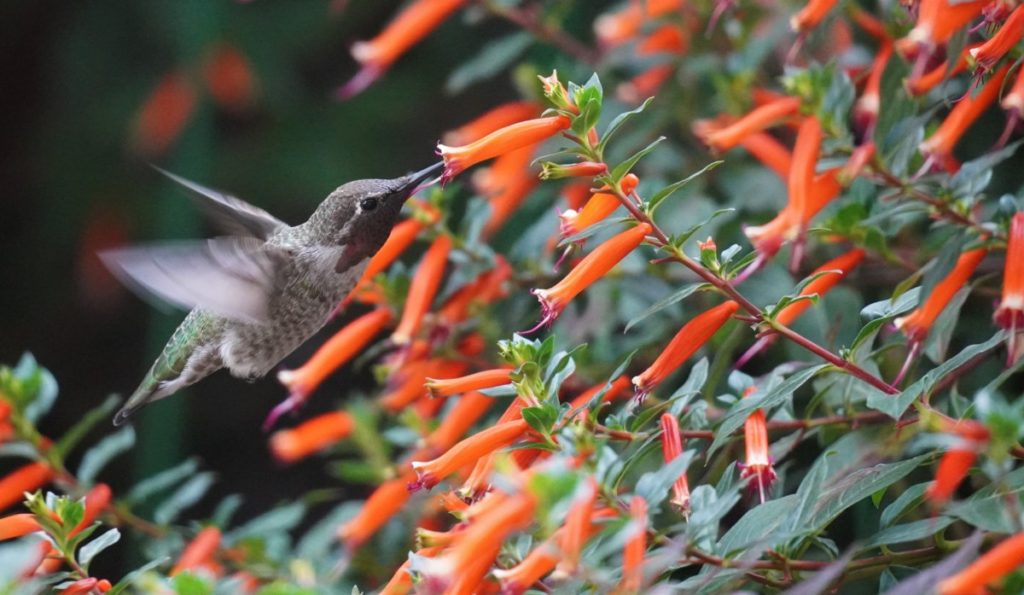
Anna’s hummingbird – (Calypte anna)
Create a forest of multi-leveled plants for an outdoor gymnasium to catch the curiosity of a hummingbird.
For more plants that attract hummingbirds see my article: Increase Backyard Hummingbird Activity in 7 Days or Less
Homemade Hummingbird Nectar
Make your homemade nectar by mixing the recommended one part sugar to four parts water and place it in your desired feeders. Remember to allow the temperature to cool completely before filling your feeder in order not to burn the tongues of the hummingbirds.
See my article: Forget Commercial Hummingbird Food Try Making Homemade Nectar
Divide the sugar water evenly among your feeders leaving a small portion to fill your handheld feeders.
Clean your hummingbird feeders every 5 to 7 days. Feeders that have been exposed to the sun are prone and susceptible to breeding bacteria and mold. When this occurs hummingbirds will catch a fungal infection on their beak or tongue limiting their intake of nutrition.
Hummingbirds see the color red more than they see the color yellow. They are inquisitive animals and their curiosity will give them the desire to scout out new red objects. Using a hummingbird feeder base that is all red, including the flowers, will result in catching a hummingbird’s attention.
Most commercial feeders have a red base with yellow, white or red flowers. Find hummingbird feeders that provide only red flowers or red slits on the base. The last option is to paint the yellow or white flowers with non-toxic red paint.
There are many pictures and videos online showing red bases with yellow or white flowers, therefore the question arises, “Why does my information sound contradicting?”
The answer could be as simple as a marketing tool that never got corrected. By being informed and knowing that hummingbirds see red and not yellow, you are already ahead of the game along with the experts in the field.
Water Elements
Any water displays that are present in your training area is an added bonus.
The sound of a stream, a fountain or a babbling brook gives the environment a relaxed, less tense or anxious ambiance. The calm sensation you may feel when listening to water is the same exact reaction that hummingbirds experience.
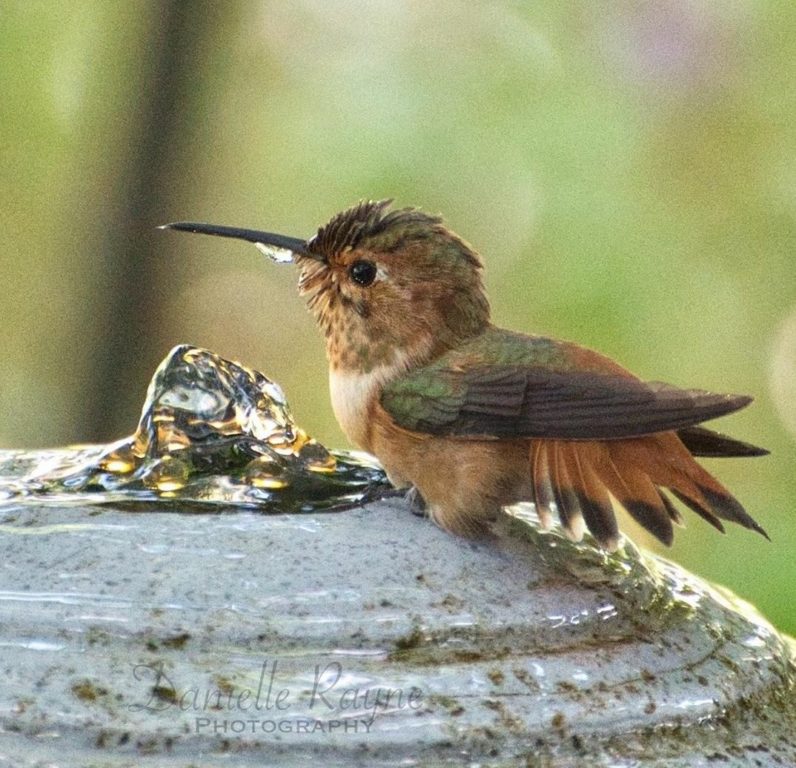
Los Angeles, California
When a hummingbird is flying, the glistening display of waterdrops will catch their attention. Whether it’s coming from a fountain, a water feature or the end of the garden hose, hummingbirds like to bathe in the shower of the water.
Hummingbirds do not have to drink water in order to survive. The liquid they receive from drinking nectar or bathing in droplets of water is enough fluid for them to sustain life.
I recently added a water feature in my backyard and have noticed a considerable increase in the duration of time a hummingbird stays and happily drinks from my feeders.
When I watch my hummingbird visitors stay longer and drink more frequently from the feeders I can actually see them physically relax while they sit comfortably on the provided perch. It almost looks like they have stopped to take a long deep breath from their busy work week. It is a fabulous thing to watch! A quick break from the non-stop movement of life is always welcome and is a lovely treat.
Backyard Friendly
Last but not least remember to make your backyard friendly and remove home pets along with other potential wild outdoor predators from your training area.
Our home pets are always curious and want to be part of a group but in this case, it is best for them to not participate in this activity. Creating less of a distraction will improve your success rate of training a hummingbird to drink out of your hand.
Pets have a natural instinct to hunt and to protect their territory. The last thing we want to do is potentially harm a hummingbird by creating a dangerous situation. Our intention is to make the hummingbirds feel safe and secure in their environment while not being harmed in the process.
Some other predators to watch out for include owls, hawks and even praying mantises. Discourage their presence as much as possible.
Refrain from using synthetic pesticides to control aphids, other insects or diseases. Ingesting these toxic chemicals will be detrimental to the hummingbird’s health.
Using products such as Fungicide3 on roses, flowers, trees and bushes to combat fungicide, insecticide or miticide contain neem oil as an ingredient but is considered safe.
Neem oil is used heavily as a pesticide generally for organic farming and has been tested as safe to use. This pesticide can be used on plants and hummingbirds can come in contact with it without harming them.
This product works wells on rose bushes to control rust and white mildew, Hot Lips Salvia for whiteflies and aphids along with controlling spider mites on Cigar Plants.
If you are wondering what a spider mite is (like I did), these pests consume sticky sap from underneath the leaves of a plant.
Fungicide3 is recommended to be used right before the sun goes down. This allows the substance to dry on the leaves overnight before the hummingbirds return to feed.
Handheld Feeders
What is the best handheld hummingbird feeder to purchase?
Purchase a red closed-top handheld hummingbird feeder. It keeps the sugar nectar from spilling onto the hummingbird’s feathers or beak and it is drip resistant. If a hummingbird’s feathers get wet with the sugar nectar, it inhibits their ability to fly and function properly.
There are a variety of handheld feeders to choose from, some simply just sit in your hand while others can be worn as a ring.
Some popular handheld feeders on the market include:
AROMA TREES Handheld Hummingbird Feeders kit on Amazon. (It even comes with a hand brush and is the most popular.)
NECTAR DOTS Hummingbird Feeder Kit on Amazon
ZUMMR Hummingbird Ring Feeder Trainer Starter Set on Amazon
Along with having handheld feeders, also purchase full-sized hummingbird feeders to entice more hummingbirds to your training area.
Popular full-sized hummingbird feeders include:
FIRST NATURE 16 oz. Hummingbird Feeder (2 Pack) Red on Amazon
FIRST NATURE 3055 32-ounce Hummingbird Feeder on Amazon
JUEGOAL 12 oz Hanging Hummingbird Feeder on Amazon (Has built-in ant moat.)
No matter what time of day, locating food is always their number one priority. You can never have too many hummingbird feeders. The goal is to attract as many hummingbirds as possible.
How long should I practice using my handheld hummingbird feeder?
After you have observed high volumes of visitors to your full-sized feeders, spend at least 20 minutes a day using your handheld feeders. Remove all of your full-sized feeders and only use your handheld hummingbird feeder. Choose the afternoon and evening time where you will witness the highest traffic activity.
The objective is to first catch the hummingbirds attention with larger feeders and have them consistently visit your backyard. This action will entice massive amounts of hummingbird traffic to your area.
Once that is established, then add the handheld feeders and take away the full-sized feeders. The idea is formed for when a hummingbird buzzes in to feed on a full-sized feeder they will have to make an extra effort to search for their missing feeders. When they do locate the feeder, low and behold they will find your handheld feeder matching the same familiar flower print as the full-sized feeder.
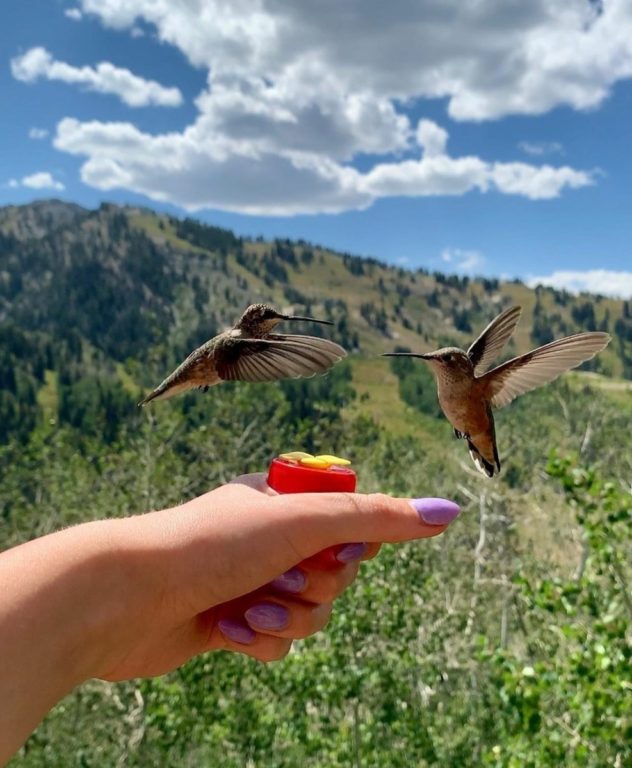
Big Cottonwood Canyon, Utah
When you have completed your 20-minute session, replace the accustomed full-sized hummingbird feeders. It’s best to repeat this 20 min training session daily until the hummingbirds are very comfortable drinking out of your hand.
How do you get a hummingbird to trust you?
Visit your training area often to have the hummingbirds associate your presence as non-threatening. Sit or stand patiently near a feeder where hummingbird activity is higher during the morning hours (to refuel their bodies) and the evening hours (to fill up before bed). Reduce the amount of background noise.
Trust and patience go hand-in-hand. We need to gain the hummingbird’s trust and tap into their curiosity in order for them to work up the courage to check out the handheld feeder on your hand.
Practice hanging out on your outside patio and sit quietly while the hummingbirds first find your large hummingbird feeders. This will give them the opportunity to adjust themselves with a new person in their space and feel less threatened.
Once you have established the trust, bring in a hand-held hummingbird feeder. In order not to tire out your arm or wrist I recommended laying your arm down on an outside table near the main hummingbird feeder.
Our goal is to become a complete statue and blend into the surroundings.
Over time it is important that we gain the hummingbird’s trust and they will come closer to the feeder on your hand. You also might be able to get a hummingbird to perch on your finger and rest while drinking the nectar. If you are extremely lucky you will have more than one friendly face competing for space or waiting patiently in line to feed out of your hand.
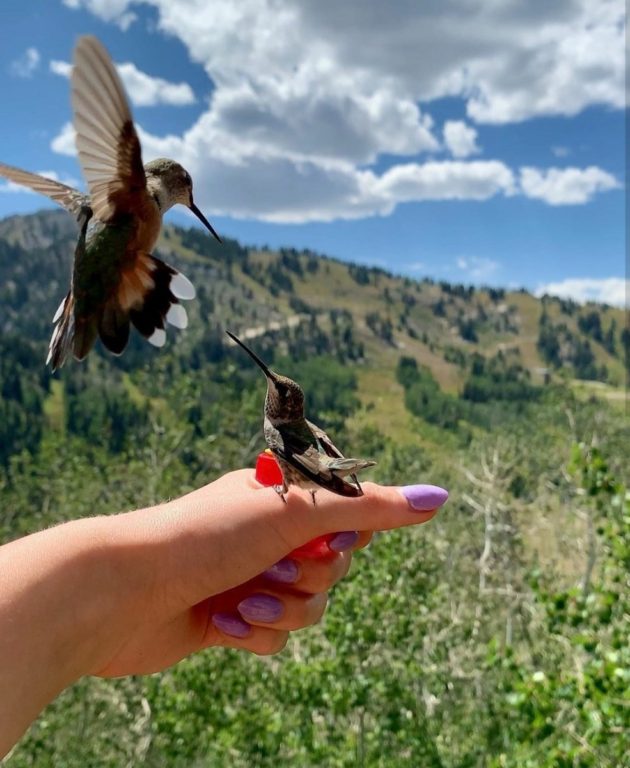
Big Cottonwood Canyon, Utah
If your hummingbirds continue to be too skittish to venture out and drink from your hand, a technique is to wear sunglasses. By doing this the hummingbirds do not see your eye movement and will improve your chances of increased participation from the hummingbirds.
Hummingbirds don’t like to feel as if “a pair of eyes” is staring at them. It reminds them too often of what a potential predator would do before consuming them as a snack. Wearing sunglasses will shield them from seeing your eyes and make them feel safer as if they are the only ones enjoying a newly discovered nectar source.
It can take several weeks for hummingbirds to become accustomed to your presence and feel safe feeding from your hands. This is a fun activity and experiment to try by yourself or with your children. Just make sure the youth are old enough to have the ability to wait patiently to reap their reward.
Have persistence and never give up!
Final Thoughts:
Training a hummingbird to drink out of your hand is easy once you have set up your training area.
First, make your area inviting by planting flowering plants that attract hummingbirds and make your homemade hummingbird food for your feeders. Fill many large hummingbird feeders with red bases and place them outside for a few days waiting for a hummingbird to locate them.
Introduce a water display to help calm our busy friends and make your backyard environment-friendly.
Once the feeders have been discovered, remove the full-sized hummingbird feeders and fill your handheld feeders. Sit patiently outside for 20 min a day. Gain their trust by sitting or standing patiently near their preferred feeder. Wear sunglasses if the hummingbirds continue to have trust issues.
Eliminate any household pet or distraction from your training area.
Neem oil products are safe to use around hummingbirds for pest issues.
Play around with these tips and see what works best for you.
Good luck!
Happy Hummingbird Training!
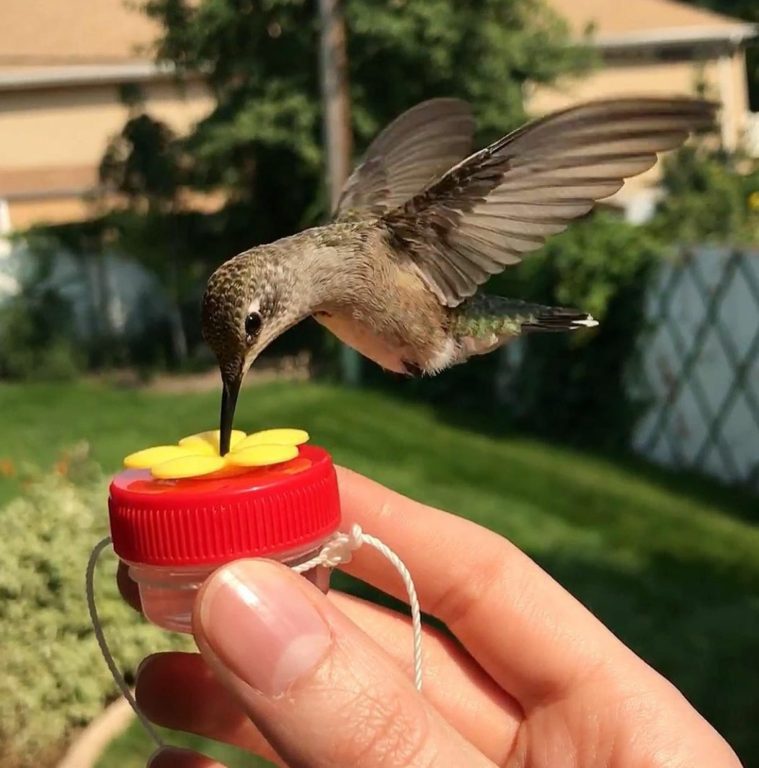
East Millcreek, Utah
Backyard Visitors participates in affiliate programs which compensate us for referring traffic.


